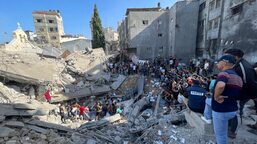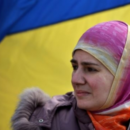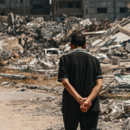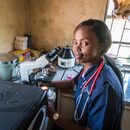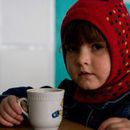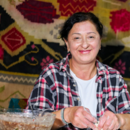The devastating war in Gaza has been ongoing since last October. It has left behind an indescribable level of destruction and suffering and has had an unprecedented impact on the civilian population there. The bombing and fighting in this enclosed strip of land have caused one of the greatest humanitarian disasters of our time. What is the situation on the ground? What is behind the conflict?
Donate and help civilians in Gaza
1. What is behind the current war in Gaza?
The tragic escalation of the conflict between Hamas and Israel was triggered by a brutal attack by Hamas fighters on Israel on 7th October, in which about 1,200 people were murdered. In addition, over 200 people were taken hostage and dragged to the Gaza Strip.
Israel's intense retaliation aiming to defeat Hamas has had a disastrous impact on the civilian population of Gaza, where 2.1 million people live in a strip of isolated land smaller than Prague. Moreover, a wall and barbed wire fence off the entire area, and there is no escape from it.
The current war is an escalation of a decades-long conflict that was sparked by the establishment of the State of Israel in the formerly Palestinian territories and the subsequent forcible displacement of Palestinians from their homes.
In 2007, the Hamas organisation took control of the Gaza Strip overthrowing the Palestinian Authority that still rules in the West Bank. Since then, the Gaza Strip has been under a long-term land, air and sea blockade by Israel. This is despite calls from the UN and human rights organisations, which have warned of the devastating impact of the embargo on civilian lives. Between 2008 and 2023, prior to the current conflict, air strikes in the occupied territories killed 6,407 Palestinians, including 5,360 in Gaza, according to the UN. During the same period, 308 Israelis were killed.
2. What is the current humanitarian situation in the Gaza Strip?
Since the 7th of October, the war has caused an unprecedented number of civilian casualties, especially in Gaza. More than 41,000 people have been killed, and another 96,000 have suffered injuries. Most of the victims are civilians. The ongoing military operations have displaced 1.9 million people, 90% of the total population of Gaza. Half of them are children. But these people have no safe place to hide. Nowhere is safe in Gaza. Moreover, many families have had to flee repeatedly in a desperate attempt to reduce the risk of imminent death at least.
The almost complete displacement, coupled with the limited supply of humanitarian aid, has created a humanitarian disaster of enormous proportions in Gaza. People are crowded in inhumane conditions in makeshift shelters, which are in short supply. They lack access to even such basic needs as drinking water, food, sanitation and health care. This leaves over 2 million people at imminent risk of famine.
Because of these dire conditions, there is a massive spread of infectious diseases. This, together with starvation, lack of sanitation and health care, means that many Palestinians, including children, are dying from easily treatable diseases. Unless there is an immediate ceasefire, the number of deaths due to current conditions will increase by a further 60-80,000 in the next 6 months, according to a study by the London School of Hygiene and Tropical Medicine.
3. Who are the people who live in Gaza?
Gaza is part of the occupied Palestinian territories, along with the West Bank. The vast majority of Palestinians living in Gaza are refugees who had been forced from their homes after the establishment of the State of Israel in 1948 and their descendants. Many of them still hope to return home. Almost half of Gaza's population lives in refugee camps.
The needs of the local population are long unmet and growing. More than 60 per cent of Gaza's population lives in long-term poverty as a result of the Israeli blockade. The unemployment rate is one of the highest in the world, reaching up to 79%. Moreover, half of Gaza's population are children and teenagers, with up to 40 per cent under the age of 14. Most young people have never left this narrow strip of land and have little or no prospect of a better future or access beyond the Gaza Strip.
The current war, in which up to 60% of homes and much of the civilian infrastructure have been destroyed so far, will further complicate the situation of Palestinians in the future. According to the UN, Gaza has turned into a dead zone.
4. Where are Gaza´s safe zones?
No place in Gaza is safe. Intense attacks and bombings are taking place all over Gaza, including in hospitals, schools, churches and other civilian buildings. Our colleague from Caritas Jerusalem, Viola, and her young daughter and husband lost their lives in the airstrike on St Porphyrios Church. Our other colleague, Issam, was killed along with his two sons in an attack on a residential house in a supposedly safe part of Gaza.
Palestinians have been gradually pushed into seemingly safer areas in the south. The May attack on Rafah ten camp killed dozens of people, many of them women and children. As a result of the Israeli offensive on Rafah, one million people have fled the area. This is to areas that lack all the necessary infrastructure and basic necessities. The situation on the ground is far beyond catastrophic.
5. What was life in Gaza prior to 7th October like?
The Gaza Strip is often compared to an "open-air prison". This densely populated enclave is fenced off by barbed wire and a wall that is forbidden to approach closer than 100 metres. Israel controls the border crossings and only allows Palestinians to leave Gaza in "sporadic cases", such as overnight labour or life-threatening situations. Moreover, as a result of the current war, Israel has completely closed its border crossings with Gaza to people and goods.
The needs of people in Gaza had already been unmet for years before the current escalation of the conflict; schools were overcrowded, and the capacity of basic infrastructure such as electricity, water, sanitation and social services was inadequate. Electricity was only available for a few hours a day, and many people did not have sufficient access to clean water. The vast majority of Gaza's population was thus dependent on humanitarian aid. Israel controls the fishing industry, and because of the long-standing blockade and dense population, people in Gaza are unable to grow enough food.
6. How does the current war in Gaza affect the region?
The current war in Gaza is also having a dramatic impact on the situation in the West Bank. The closures and blockades of Palestinian towns, as well as the absence of tourists and pilgrims, spell disaster for the people there. People have lost their primary source of income and the ability to continue to earn a living. In addition, hundreds of families in the West Bank have been forced to flee their homes, and the level of violence by settlers and the Israeli army against Palestinians has increased dramatically.
People from villages often commute to the cities for work and cross checkpoints into Israel on a daily basis. However, in times of war, movement through the checkpoints is forbidden, and work permits to enter Israel have been withdrawn, exacerbating the population's problems. Employment has risen to 32%, representing 276,000 jobs that have been lost due to the closure and revocation of work permits to enter Israel.
Tensions have also increased significantly throughout the Middle East as a result of the war.
7. How is Caritas helping in Gaza?
Despite the dire conditions, Caritas is still helping on the ground. Our partner organisation Caritas Jerusalem been operating in Gaza for a long time. In cooperation with Caritas Jerusalem, Caritas Czech Republic is providing medical care for 5,000 local residents.
Caritas has been helping since the beginning of the escalation of the conflict in the Gaza Strip, despite the dire conditions. Our partner organisation Caritas Jerusalem provides primary health care directly in Gaza. It currently has 94 staff in Gaza, mainly doctors, nurses or pharmacists, who are divided into 12 medical teams, 11 of which provide assistance in central Gaza, where most of the displaced people are located. One of the teams remains in Gaza City, where the original main centre of Caritas Jerusalem, which has long been active in the area before the escalation of the current conflict, was located. The central health centre was damaged as a result of the war, but our colleagues are trying to rebuild it.
Caritas is also actively involved in helping civilians in the West Bank. Our partner organisation, Caritas Jerusalem, is helping in 30 villages and the Jenin refugee camp. In collaboration with Catholic Relief Services, they provide basic humanitarian and medical assistance, including psychosocial support.
Caritas Czech Republic has long called for an immediate ceasefire, the release of all hostages and arbitrarily detained persons and the provision of adequate humanitarian aid.
We thank all those working with us to help civilians in Gaza.
Donate and help civilians in Gaza








